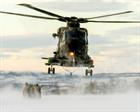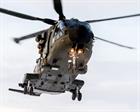MERLIN MAGIC IN THE ICE CAPPED MOUNTAINS
THE wings of the Royal Marines have completed a month of arduous Arctic training in the snow-covered wilds of northernNorway.
845 Naval Air Squadron – currently based at RAF Benson in Oxfordshire – took two of their new Merlin helicopters on a 3,000-plus-mile odyssey to deep inside theArctic Circle.
After a three-day flight from their home in Somerset (via Aalborg in Denmark and Stavanger in western Norway), the helicopters arrived at the Norwegian Air Force base in Bardufoss, used by the Commando Helicopter Force for decades.
This year is the first that has not seen Sea Kings over theArctic; the veteran workhorses of CHF were left behind in Yeovilton as they retire from active duties at the end of March 2016.
Its replacement is the battlefield Merlin: big, green, faster, more powerful, greater range, equipped with a computerised cockpit.
The Merlin has limited experience in operating in such an extreme environment (deep snow, very limited hours of daylight, and temperatures below -30°C in the depths of winter) – it only made its debut at Bardufoss a couple of years ago, whereas Sea Kings have been operating in theArcticfor 35 years.
So nearly 60 men and women, mostly from 845 Naval Air Squadron, a handful of comrades from 846 Squadron, half a dozen RAF personnel – the Merlins were transferred to the Fleet Air Arm from the air force (some of the helicopters still bear the insignia) – headed to Norway for Exercise Clockwork (it’s as regular as), many for the first time.
Before air or ground crew could give any thought to flying the two Merlins, all personnel had to undergo the cold weather survival course (which teaches how to survive in cold weather…), because the Commando Helicopter Force are more likely to operate in the field than any other branch of the Fleet Air Arm.
Once accustomed to the world of snow holes, ice breaking (jumping into icy water, clambering out again with kit), living off the land, the squadron was ready to take to Norwegian skies.
“This was my first time inNorwayand it has been a very different environment to work in – but I think we met the challenges well,” said Air Engineering Technician Ryan Stuart.
“It makes a change from normal, warmer conditions and has required a different set of skills. It has also been great to work with the Norwegian military and provide help to the local population and rescue services.”
They carried out 350 landings in the snow by day and night – the powerful down draught from the Merlin’s rotor blades throws up a veritable snowstorm as it comes into land, depriving the aircrew of visibility.
The helicopters flew an average of four sorties a day during the 18 days they were required, clocking up 120 hours in Arctic skies, with navigation, load ferrying and general mountain flying duties all carried out.
Most importantly, 11 pilots and the same number of aircrewmen – responsible for the safety of the troops being carried and the handling of the aircraft when landing in tight spots or carrying loads – earned their Arctic qualifications.
“As the squadron’s most junior aircrewman, I was very much looking forward to my first detachment,” said Corporal Simon Wynne RM.
“The Arctic environment provided new and unique challenges – both for me and the Merlin, but this month has helped develop my operating ability and experience tremendously.”
As a thank-you to their hosts, the Merlins lifted two tonnes of timber and flew it to remote huts to help National Park Rangers; work which would have taken more than a month using skidoos took a pair of Merlins one morning.
Working in mountainous terrain and sub zero temperatures, engineers loaded and then safely unloaded the wood at their destination.
“Clockwork remains one of the very best training establishments available,” said 845’s senior pilot Lt Cdr Edward Vaughan, in charge of the detachment at Bardufoss. He was on his third deployment toNorway– but his first with Merlin.
“I am immensely proud of the engineering and support team who have achieved magnificent levels of serviceability. This, coupled with the hard work of the aircrew instructors, has enabled us to surpass our training expectations and come away from theArctic Circlebetter prepared for operations in a cold weather mountainous environment. “
Returning to RAF Benson in Oxfordshire this week, 845 NAS will continue their Merlin training through the spring before moving to Yeovilton in the summer to join the rest of the battlefield Merlins at the Commando Helicopter Force’s spiritual home.






